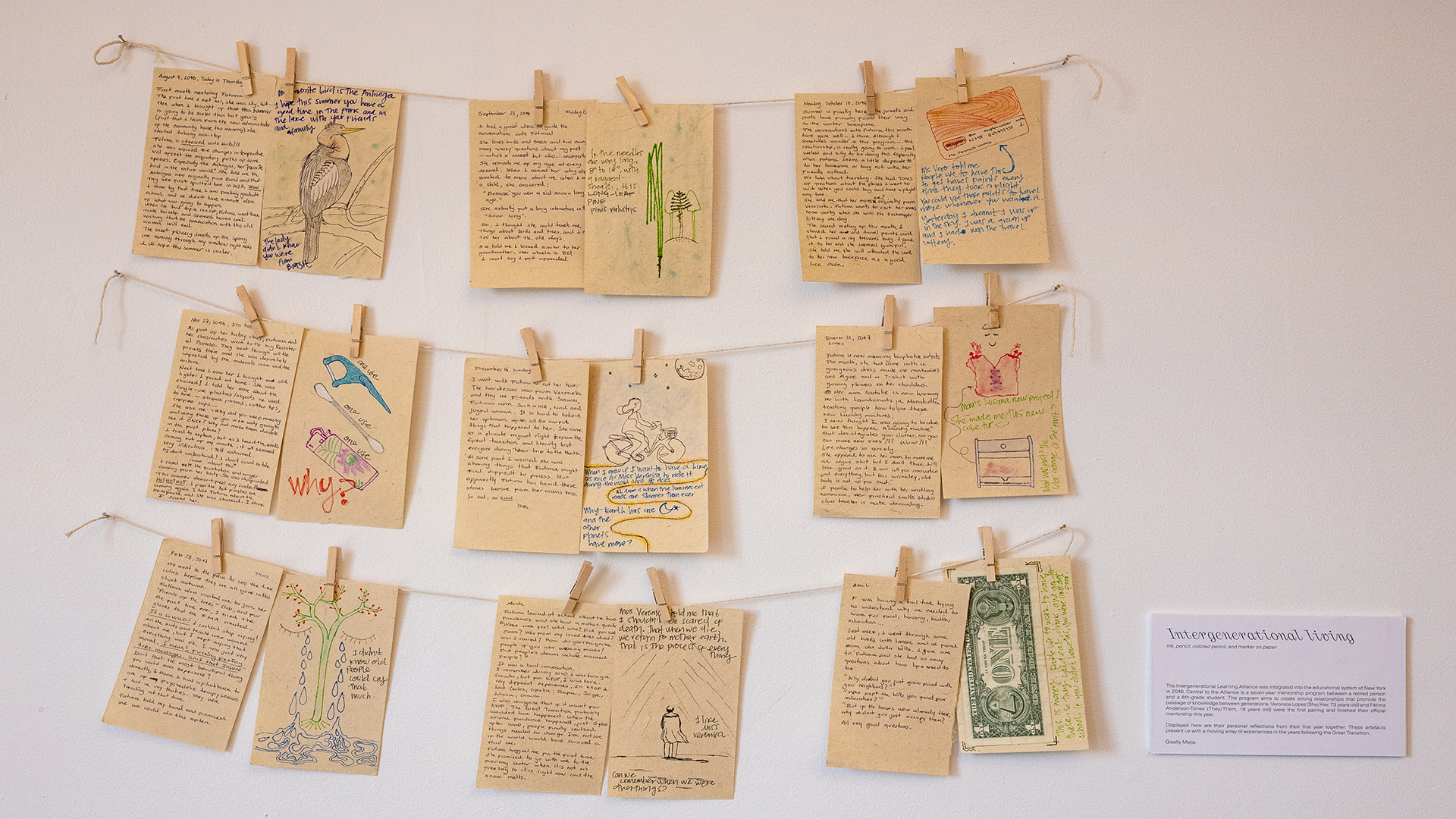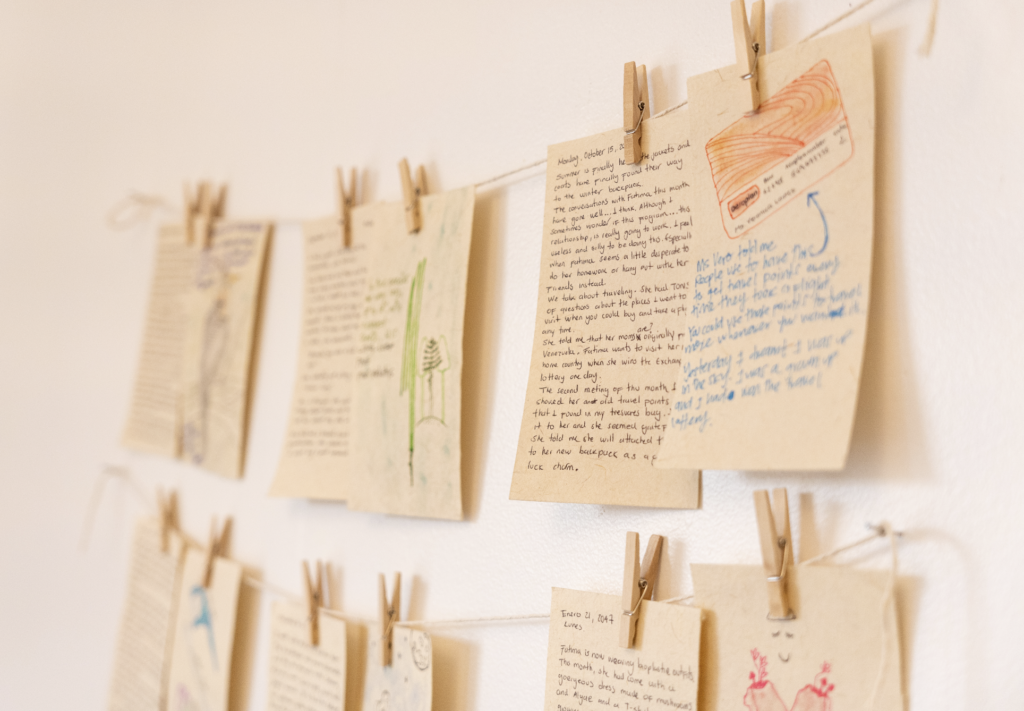Timeline: April to May 2023 (2 months).
Team: Giselly Mejia.
My role: Researcher, Imaginer, and Illustrator.
Approach: Worldbuilding, Design Fiction, storytelling.
Topics: Intergenerational relationships, Post-growth, Climate Activism.
The Intergenerational Learning Alliance was integrated into the educational system of New York in 2046. Central to the Alliance is a seven-year mentorship program between a retired person and a 6th-grade student. The program aims to create strong relationships that promote the passage of knowledge between generations and improve the relational and emotional skills of the youth. Veronica Lopez (She/Her, 73 years old) and Fátima Anderson-Torres (They/Them, 18 years old) were the first pairing and finished their mentorship this year.
During the program’s first year, Veronica and Fatima needed to handwrite their reflections after each encounter. These reflections present us with a moving array of experiences and emotions in the years following the Great Transition.
Project Statement
This project takes place in 2053, in a post-growth New York City that has shifted its values to adapt to the new world after the Great Transition, a period of radical transformation due to the challenges proposed by Climate change. In this speculative vision, intergenerational learning has been integrated into New York’s educational system to engage a growing aging population in exchanging knowledge and improving relational and emotional skills in younger generations.
Two fictional characters, an 11-year-old (descendent of climate migrants) and a 63-year-old, embark on a seven-year-long mentoring program in which they create monthly handwritten reflections during their first year together. These fictional artifacts portray not only the complexities of an intergenerational relationship but also give us hits into a future where biomaterials, further transportations norms, changing climate and migratory bird patterns, new relationships of kinship, and collaboration with the more-than-human are part of the daily life of Nueva New York residents. Additionally, the artifacts present a critical reexamination of the current economy of consumerism, accumulation, capital, and production of waste.
The Great Transition is a fictional period of economic, social, and political transition from the growth-oriented system of Capitalism to an economy centered on meeting the needs of the land and the people. The Great Transition refers to other significant transformation periods like the Great Depression and the Great Resignation.
Outcomes
Projects details
This project is part of the collective thesis project Making Tomorrows: Inquiries into Alternative Futures. This subset speculative project was created as an individual reflection that allowed me to explore my subject interests and futuring methodologies within a post-growth future while simultaneously opening conversation amongst ourselves (the thesis team) about the points of tension and harmony within our group.
To arrive at these design fiction artifacts, I used signal scanning, scenario building, persona creation, and interviews to construct the object narratives. The artifacts were exhibited in our thesis presentation at Parsons School of Design on May 2023.
Signal Scanning
- American Association of Retired Persons – AARP:
AARP is a nonprofit, nonpartisan organization that empowers people to choose how they live as they age.- AARP Livable Communities Are Age-Friendly: Supports the efforts of neighborhoods, towns, cities and rural areas to be great places for people of all ages. We believe that communities should provide safe, walkable streets; age-friendly housing and transportation options; access to needed services; and opportunities for residents of all ages to participate in community life.
- AARP Foundation Experience Corps: AARP Foundation Experience Corps is a community-based volunteer program that empowers people over 50 to serve as tutors to help students become better readers by the end of third grade.
- Tommi Laitio: Former Director of Youth Affairs at Helsinki´s city government in 2012. He has led the construction of a new model for citizen engagement in Helsinki.
- Aging in the United States:
- The number of Americans ages 65 and older is projected to nearly double from 52 million in 2018 to 95 million by 2060, and the 65-and-older age group’s share of the total population will rise from 16 percent to 23 percent.
- The older population is becoming more racially and ethnically diverse. Despite the increased diversity in the older adult population, the more rapidly changing racial/ethnic composition of the population under age 18 relative to those ages 65 and older has created a diversity gap between generations.
- The ‘Devil Bird’ Lands in New York, With More Likely to Come: Anhingas, water birds with snakelike necks, have turned up in Prospect Park in Brooklyn and far upstate, a sign of shifting ranges for birds from the South.
- Shifting Seasons: The growing seasons are shifting. Spring is arriving earlier, winters are shorter, and the number of freezing days is declining. These changes affect the timing of many life cycle events, such as when flowers bloom or when pollinators emerge. Changes in the timing of these events — spring thaw or songbird migration, for example — can have adverse effects on ecosystems, because different species may respond to different environmental cues, resulting in a misalignment between species that may rely on one another.
- Environmental Mobility. The Responsibility of the International Community: Tens of millions of people will move or be dislocated by environmental events over the next several decades. Some will be forced from their homes because of disasters; others will choose to leave as they foresee an intolerable future. Departures may be short term—once the waters recede, the rains come, or earthquake‐shaken towns rebuild, people will return to their home communities. For many, however, their movement from home may be permanent.
- The Comeback of Biomaterials. A Sustainable Solution to Conventional Plastics: Research into the production and commercialisation of new and more sustainable materials, that have at least the same properties as traditional plastics, is on the rise. Thanks to the fast-growing biotechnology sector, new consumer goods such as nylon made using genetically engineered microbes and alternative leather made from mushroom roots or cacti are arising.
- Branching out: is communication possible between trees and people?: Trees communicate with each other, store memories and respond to attacks. They have a profoundly positive effect on our emotions … but can we know how they feel about us?
Persona creation
Interviews and field research with children paired with my own experience as an immigrant was used to create the two personas part of this project.
Scenario building – [Worldbuilding expert]
The Intergenerational Living Alliance is a New York association that supports the efforts of neighborhoods, towns, cities, and rural areas to be great places for people of all ages. The International Living Alliance focuses on addressing the issues affecting people’s access and enjoyment of the social and built environment.
In the first years of the Great Transition, the former American Association of Retired Persons restructured its name and mission to accommodate the rising demands of the people in New York. The number of Turtle Islanders ages 65 and older nearly doubled from 52 million in 2018 to 90 million by the end of 2052. The Intergenerational Living Alliance has enabled the transformation of lives through its collaborative work on housing, transportation, education, outdoor space, social and civic participation, healthcare, and inclusion.
The Intergenerational Living Alliance voting assembly is located in Nueva New York but has 35 affiliated sub-organizations in other bioregions created through voting assemblies and referendums in different communities. Between those are the Legal Counsel for the Elderly, Intergenerational Climate Reconciliation Foundation, Restorative Justice for the Elderly and the Intergenerational Learning Program. The latter was integrated into the educational system of Nueva York in 2038 to promote the passage of knowledge from a growing aging population that was becoming more racially and ethnically diverse. The program started with a call for participants 50 years old that would be paired with third-grade children of climate migrants. The project quickly evolved into a city-wide program that integrated all public elementary schools in Nueva York Students showed an increased sense of personal responsibility, relationship skills, and decision-making.
In 2046, a new pilot program started within the organization: a seven-year mentorship between retired people and students in 6th and 7th grade. This partnership seeks to create strong intergenerational relationships that go beyond regular school topics and explore the complexities of human connections in a post-capitalist world.




